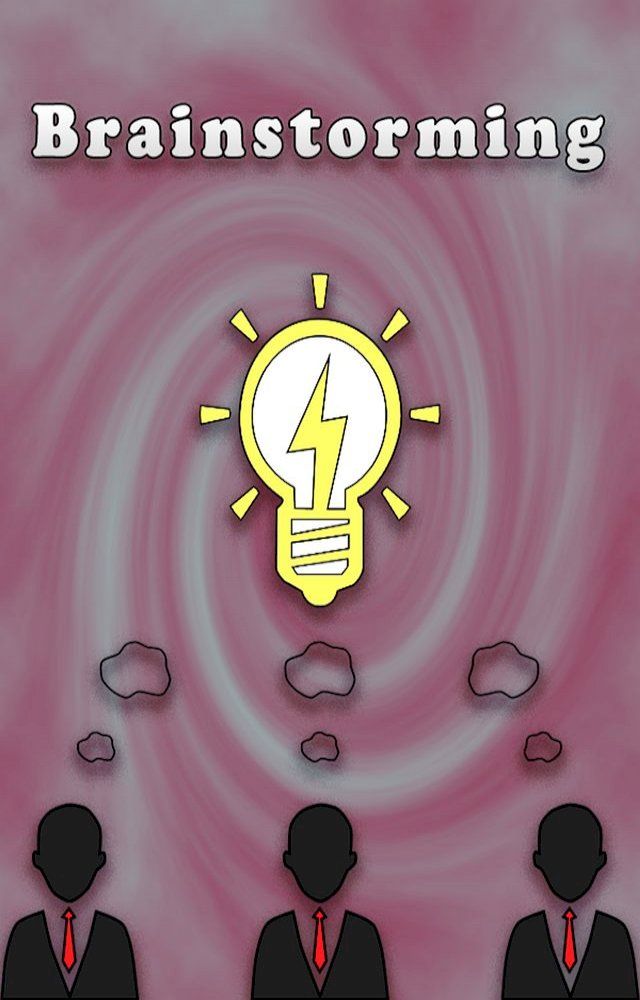Brainstorming(Kobo/電子書)
- P幣
全盈+PAY 單筆滿1200回饋80P幣(限量)
- 登記送
11/01-11/07【加碼送300P幣-資格登記B】百貨指定單筆滿$1500 即可進行登記
- 登記送
11/2全百貨指定品單筆滿$3000登記送BOXMAN x WOKY保溫杯(顏色隨機/限量)
- 信用卡、無卡分期、行動支付,與其他多種方式
- PChome 聯名卡最高6%,新戶再享首刷禮1000P
- 廠商出貨本商品不受24h到貨限制
- 電子書非實體商品,發送方式詳見商品頁說明
- 宅配到府(本島/低溫)滿$699免運
- 宅配到府(本島/常溫)滿$490免運
- 超商取貨(常溫)滿$350免運
- 超商取貨(低溫)滿$699免運
- i郵箱(常溫)滿$290免運
作者: | |
ISBN: | 1230003047514 |
出版社: | |
出版日期: | 2019/01/25 |
內文簡介
Creative ability is most frequently the opposite of good judgment.
Creative ability includes the tendency to experiment with novel ideas that might be unsound. It includes a good deal of the gambler’s spirit where the individual “sticks his neck out” and tries something new, perhaps even “wild” or “crazy.” Therefore, by its very nature, creative ability is on the opposite end of the scale from good judgment.
But must judgment be developed at the expense of imagination?
we have had experience that proves that ideas can be stimulated and that a climate can be developed, and maintained, in which ideas— as well as good judgment—flourish. We have drawn freely on all sources of research and information and have reached these conclusions, for example, as to what a creative person is.
In the first place, he has a sensitivity to problems. Then he also has a fluency with ideas in that he thinks of a lot of approaches to a problem. Many of these ideas are characterized by novelty. His ideas are new and perhaps different.
The creative man is flexible, able to drop one line of thinking and easily take up another one. Also, he has a quality that has been described as constructive discontent, a certain restlessness of mind, searching for new and better ways of doing things.
In other words, if we were to draw a line to represent the various degrees of creative ability and sound judgment, we would put great creativity at one end and sound judgment at the other. The better manager, when rated along this line, would be much closer to the good judgment end than to the creativity end. So we immediately see that a “good manager” may automatically constitute a barrier to an atmosphere that fosters creativity. Consequently, this is a real challenge to business leaders: how to combine a flow of creative new ideas with sound evaluation.
Yet I feel that it is absolutely necessary to cultivate the “idea atmosphere” if an organization is to forge ahead day after day. Business, just as art, needs a climate of open-mindedness—and should not be wary of non-conformists or men who continually pose ideas that run contrary to our orthodox thinking.
When a person is faced with a problem, it seems natural to fall back upon previous experience for answers. In most cases, judgment dictates what is most practical or what has worked in the past. This judgment is the end result of training, which has been instilled in the individual throughout most of his life. From the time the child is old enough to comprehend, he is taught to do what is “best” for himself and for others. He is trained to do the “right” thing. This, then, is the beginning of judgment. This process continues throughout his growth to maturity.
What happens during this period when judgment is developing? What was there before judgment developed? Let’s look at a young child. One is immediately struck by his power of imagination. Everything is “real” to him. Everything is alive. The stick he picks up and aims is a gun. The tree he climbs is a mountain or a ship’s lookout platform.
Imagination is tolerated in a child but not always encouraged. As he grows older, he is impressed with the fact that his imagination, while a source of amusement, is often not practical. Thus we see that judgment may take the place of imagination completely—or that imagination will be used less and less as judgment is used more and more.
Theoretically, this could lead to a person’s having all judgment and no imagination—and don’t we seem to run into those persons? Don’t some people seem to rely entirely on precedent and experience and seem afraid to try a new slant?
More than one thousand of our people have taken this creativity training, and we know it produces good results. Brainstorming is an important part of this course.
We started out by training the course on our top executives. They were convinced it could stimulate people into thinking up ideas that would help the entire division. From them we went on to give the course to our engineering people and then to manufacturing supervision.
Everybody seems to like the creativity work. It is, in fact, the most popular of all our educational activities. We have “discovered” that folks like to give their imaginations a workout and, once they know ideas are welcome, they will come up with many good suggestions.
I am proud of the fact that for the past several years our division of General Motors has been a leader in the GM Suggestion Plan. This record stems, at least in part, I feel, from the “climate,” the idea-atmosphere, that pervades our organization. That, I believe, is the most important single result to come from our continuing creativity program.
Surely we teach people some specific ways to generate ideas. The techniques described by Charles Clark in this book are followed, and I might say I’ve even learned some new ones from him. But, above all, we have tried to create a definite feeling among our people, especially our management and technical groups, that our division has a “wide-open mind.” I don’t believe anybody feels he will be criticized for suggesting something new, untried, or different, even if it might seem “screwball.”
We all have this inherent capacity to focus ... but at the same time, attention is a limited resource. Not only should we be aware of this, but treat it as such: something most valuable.
In this book we will be looking at our capacity to Focus from a whole variety of angles. From brain systems and neurochemicals, over the impact of survival instincts and emotions, to the different types of distractions we're facing. There will be a whole pallet of advice and insights, as well as tips, tricks and strategies presented to help you gain substantial improvement in your capacity to focus.
How do I improve my brain’.
This book is our answer to that one question. Because, as much as we would’ve liked to reveal the one magical trick to significantly enhance our brain, it simply doesn’t work that way. As we will see, there is no scientific evidence to back up the claims of brain games and other programs, even though they claim they do.
Your Brain Is Like Any Other Muscle In Your Body
Unfortunately, most people just don’t realize that this is possible…
Or maybe you think that improving your brain’s performance will be extremely time-consuming.
It’s understandable to be concerned about your time.
After all, so many of us have so very little of it these days.
Our modern lives are stressful, and with daily work and other obligations, most people struggle to even find the time to go to the gym to train their physical bodies…
But, Learning To Improve Brain Health Is Actually Even More Important In Many Ways Than Exercising Your Body…
That’s because, everything starts in your brain.
And when your brain is operating at the highest level possible, if can improve EVERY single aspect of your entire life.
What’s really exciting is that we’re just starting to understand just how important brain health really is.
Just a few years back, most people didn’t even realize that they had the opportunity to improve their brain’s health.
But, science has proved that our brains continue to grow, develop, and change throughout our lives…
That means you can create new memories, learn new things, and new brain cells are formed throughout your brain in a process called neurogenesis.
This mean you have the opportunity to…This book will help your memory:
* Improve your focus - by applying a whole set of strategies
* Understand the mechanism driving focus - by exploring theories and scientific studies
* Explore why and how we loose our focus - by participating in mindbending tests and experiments
* Create the right conditions - both internally and externally, to have your brain operate in optimal conditions and at full speed
* And So Much More... such as multi-tasking, survival skills, network of neurons, ego depletion, dopamine, quality control, wine tasting,
and so on ...
ORDER NOW!Kobo 電子書 購買注意事項如下:
(一)如果您是第一次購買Kobo電子書的顧客,請依以下兩種購買方式擇一進行綁定:
1.PChome 24h 網頁版(https://24h.pchome.com.tw/):結帳後至顧客中心,確認訂單狀態,若為確認中,請稍候五分鐘,待訂單狀態變為訂單成立後,點選明細,在訂單資訊中點選〔內容〕,在彈跳視窗後點選〔去兌換〕,即可前往Kobo官網執行綁定及登入流程。
我的訂單/顧客中心 >訂單查詢> 訂單編號> 點選明細 > 訂單資訊 點選〔內容〕>彈跳視窗 點選〔去兌換〕即可前往Kobo官網執行綁定及登入流程。
2.PChome APP版:結帳後至顧客中心,確認訂單狀態,若為確認中,請稍候五分鐘,待訂單狀態變為訂單成立後,點選明細,在訂單資訊中點選[序號/軟體下載],並在彈跳視窗出現後點選〔下載連結〕,即可前往Kobo官網執行綁定及登入流程。
顧客中心> 訂單查詢> 訂單編號> 點選明細 > 訂單資訊 點選 [序號/軟體下載] >彈跳視窗 點選〔下載連結〕即可前往Kobo官網執行綁定及登入流程。
*進入Kobo官網後的綁定流程請參考如下:
(使用Kobo主帳號 登入/註冊)
1. 當您在PChome 24h 網頁版(https://24h.pchome.com.tw/)/PChome APP版,購買確認後,並依步驟跳轉到Kobo官網時,下滑點選〔更多登錄選項〕,由〔PChome〕後點選進入,同意後登入,並可以註冊Kobo主帳號進行綁定,完成後,所購買的書籍即會出現在Kobo APP/Kobo 閱讀器/Kobo官網內的我的書籍。(使用快速登入:FACEBOOK、GOOGLE、APPLE帳號登入)
2. 當您在PChome 24h 網頁版(https://24h.pchome.com.tw/)/PChome APP版,購買確認後,並依指示跳轉到Kobo官網時,點選〔FACEBOOK、GOOGLE、APPLE帳號登入〕擇一登入,同意後登入,並可以註冊Kobo主帳號進行綁定,完成後,所購買的書籍即會出現在Kobo APP/Kobo 閱讀器/Kobo官網內的我的書籍。(二)如果您是已經完成PChome與Kobo帳號綁定程序,非第一次購買Kobo電子書的顧客
1.PChome 24h 網頁版(https://24h.pchome.com.tw/):結帳後至顧客中心,確認訂單狀態,若為確認中,請稍候五分鐘,待訂單狀態變為訂單成立後,點選明細,在訂單資訊中點選〔內容〕,在彈跳視窗後點選〔去兌換〕,所購買的書籍即會出現在Kobo APP/Kobo 閱讀器/Kobo官網內的我的書籍。
2.PChome APP版:結帳後至顧客中心,確認訂單狀態,若為確認中,請稍候五分鐘,待訂單狀態變為訂單成立後,點選明細,在訂單資訊中點選[序號/軟體下載],並在彈跳視窗出現後點選〔下載連結〕,所購買的書籍即會出現在Kobo APP/Kobo 閱讀器/Kobo官網內的我的書籍。
- 退換貨:依樂天Kobo官方規範為準
- 僅能由 閱讀器以外 的裝置做會員帳號綁定
- 請注意,帳號綁定後:
* Kobo會更新您的帳戶詳細資料
* 您將能在Kobo APP/Kobo 閱讀器/Kobo官網中查看所有書籍
* 帳號綁定後,您可以使用任一帳戶登入 Kobo
* 完成第一次串接時,請登出所有裝置,約等待5分鐘後再登入即可查看您的書籍
* 重新登入後,原帳戶中的書籍如有畫線註記和收藏將有遺失的可能。登出前,請務必先行拍照備份
* 若您有任何相關疑問請至Kobo官方網站 https://help.kobo.com/hc/zh-tw 並到頁面最下方點選“聯繫我們”
1. 出版地:台灣
2. 本商品為數位內容商品,非實體紙本書籍
3. 完成購買後,請使用Kobo App、Kobo桌面閱讀軟體Kobo Desktop或Kobo閱讀器閱讀。App詳情請見:https://www.kobo.com/tw/zh/p/apps
4. 下載格式:Epub2-流式格式
樂天Kobo官方授權銷售
1. 訂單確認交易成功後,系統會自動將書籍匯入帳戶
2. 請使用樂天Kobo提供的閱讀程式或裝置閱讀
3. 訂單及書籍問題請聯繫PCHOME客服中心
相關分類
| 寄送時間 | 預計訂單成立後7個工作天內送達不含週六日及國定假日。如廠商有約定日將於約定日期內送達,約定日期需於訂單成立後14天內。 |
|---|---|
| 送貨方式 | 透過宅配或是郵局送達。 消費者訂購之商品若經配送兩次無法送達,再經本公司以電話與E-mail均無法聯繫逾三天者,本公司將取消該筆訂單,並且全額退款。 |
| 送貨範圍 | 限台灣本島地區。注意!收件地址請勿為郵政信箱。 若有台灣本島以外地區送貨需求,收貨人地址請填台灣本島親友的地址。 |
| 執照證號&登錄字號 | 本公司食品業者登錄字號A-116606102-00000-0 |
- PChome24h購物的消費者,都可以依照消費者保護法的規定,享有商品貨到次日起七天猶豫期的權益。(請留意猶豫期非試用期!!)您所退回的商品必須回復原狀(復原至商品到貨時的原始狀態並且保持完整包裝,包括商品本體、配件、贈品、保證書、原廠包裝及所有附隨文件或資料的完整性)。商品一經拆封/啟用保固,將使商品價值減損,您理解本公司將依法收取回復原狀必要之費用(若無法復原,費用將以商品價值損失計算),請先確認商品正確、外觀可接受再行使用,以免影響您的權利,祝您購物順心。
- 如果您所購買商品是下列特殊商品,請留意下述退貨注意事項:
- 易於腐敗之商品、保存期限較短之商品、客製化商品、報紙、期刊、雜誌,依據消費者保護法之規定,於收受商品後將無法享有七天猶豫期之權益且不得辦理退貨。
- 影音商品、電腦軟體或個人衛生用品等一經拆封即無法回復原狀的商品,在您還不確定是否要辦理退貨以前,請勿拆封,一經拆封則依消費者保護法之規定,無法享有七天猶豫期之權益且不得辦理退貨。
- 非以有形媒介提供之數位內容或一經提供即為完成之線上服務,一經您事先同意後始提供者,依消費者保護法之規定,您將無法享有七天猶豫期之權益且不得辦理退貨。
- 組合商品於辦理退貨時,應將組合銷售商品一同退貨,若有遺失、毀損或缺件,PChome將可能要求您依照損毀程度負擔回復原狀必要之費用。
- 若您需辦理退貨,請利用顧客中心「查訂單」或「退訂/退款查詢」的「退訂/退貨」功能填寫申請,我們將於接獲申請之次日起1個工作天內檢視您的退貨要求,檢視完畢後將以E-mail回覆通知您,並將委託本公司指定之宅配公司,在5個工作天內透過電話與您連絡前往取回退貨商品。請您保持電話暢通,並備妥原商品及所有包裝及附件,以便於交付予本公司指定之宅配公司取回(宅配公司僅負責收件,退貨商品仍由特約廠商進行驗收),宅配公司取件後會提供簽收單據給您,請注意留存。
- 退回商品時,請以本公司或特約廠商寄送商品給您時所使用的外包裝(紙箱或包裝袋),原封包裝後交付給前來取件的宅配公司;如果本公司或特約廠商寄送商品給您時所使用的外包裝(紙箱或包裝袋)已經遺失,請您在商品原廠外盒之外,再以其他適當的包裝盒進行包裝,切勿任由宅配單直接粘貼在商品原廠外盒上或書寫文字。
- 若因您要求退貨或換貨、或因本公司無法接受您全部或部分之訂單、或因契約解除或失其效力,而需為您辦理退款事宜時,您同意本公司得代您處理發票或折讓單等相關法令所要求之單據,以利本公司為您辦理退款。
- 本公司收到您所提出的申請後,若經確認無誤,將依消費者保護法之相關規定,返還您已支付之對價(含信用卡交易),退款日當天會再發送E-mail通知函給您。


